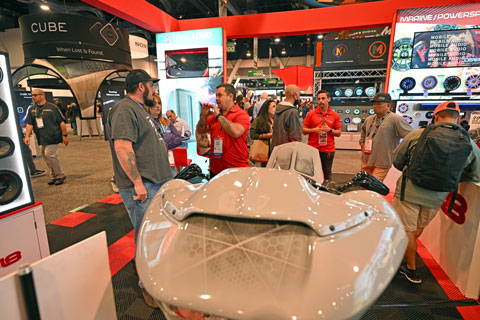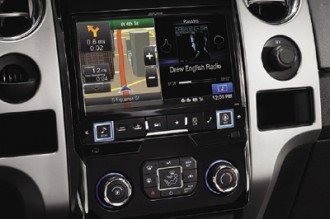SEMA News—June 2015
MOBILE ELECTRONICS
By Steve Campbell
Smartphones, Compact Solutions and Distraction Reduction
More Information and Entertainment Come Into the Car
| |
“We have products that allow talking on the phone hands-free, sending and receiving text messages using voice to dictate to the phone and then have it read back to you over the car speakers,” said Ted Cardenas, vice president of marketing for the car electronics division of Pioneer Electronics USA Inc. “The driver can use mapping and turn-by-turn navigation and access music that is either stored on the phone, streamed in from the cloud or from various other music services, such as satellite radio. They can bring in the latest map data and traffic information via the cloud.”
Those Pioneer systems work with the new Apple CarPlay and Android Auto software packages to display the smartphone’s interface on a receiver’s touchscreen, and Alpine has a CarPlay-compatible unit. CarPlay connects to the Pioneer receivers using Apple’s Lightning-to-USB cable, and Android Auto is connected through a micro USB cable. Both use familiar interfaces to incorporate popular apps that users access frequently, eliminating a learning curve so that the functions and apps are easy to understand and easy to use. Several of the OEM automakers also offer receivers that are compatible with Apple CarPlay and Android Auto as factory options on some ’14-and-later models.
“Smartphones are central to most people’s lives,” said Nathan Wincek, director of product development for AAMP of America. “It’s their source of entertainment, a connection to their loved ones and a work hub when they are on the go. Naturally, the desire exists to access all of these features and functions while in the car, but drivers need to do it safely. AAMP recognizes this need, which is where our line of products comes in. They give smartphone users the connectivity they crave with the safety they need.”
AAMP and other electronics manufacturers offer a variety of hands-free and audio-streaming Bluetooth solutions as well as smartphone-based navigation through phone mirroring. They also offer backup cameras and interfaces, blind-spot elimination camera systems, driving-event recording devices and other driver behavior tracking and vehicle diagnostics systems. Distracted driving is one of the leading causes of accidents, especially among teenage drivers, so developing distracted-driving solutions is at the forefront for product development teams.
“Most new-car advertisements today have a strong emphasis on safety capabilities over other features such as engine performance,” said Tom Malone, president of VOXX Electronics Corp. “As manufacturers of consumer electronics, we see the importance of developing new technologies that help ensure the safety of consumers and turn the tide of the current epidemic we face today. While we can’t force drivers to put down their cell phones or pay closer attention to the road ahead, we can continue to develop products, such as lane-departure and forward-collision warning systems, to give drivers another level of safety behind the wheel.”
| |||
| |||
“Platform flexibility allows the multiple media options available to consumers today,” said Steve Brown, senior restyle development manager for Alpine Electronics of America Inc. “It also allows them to have choices in their system design. For example, we offer multiple screen options, including an industry-leading 9-in. screen, to give customers a choice beyond the typical aftermarket-industry standard 2-DIN or 1-DIN audio options.”
Another trend is attributable to rising fuel costs. Even though gas prices plummeted in the recent past, the auto market shifted some production to smaller vehicles. Those types of cars and trucks call for more compact components, which are advantageous in any type of vehicle.
“We are making a concerted effort to make smaller and lighter audio performance products,” said Cardenas. “A lot of advancements in technology are far more efficient electrically, such as class D amplifiers. We can create an amplifier that is more powerful in the same size or the same power but considerably smaller and lighter in weight with upward of 80% efficiency, which means that 80% of the electricity that goes into the device gets turned into mechanical energy that turns into sound as opposed to being turned into heat.”
Cardenas at Pioneer and Wincek at AAMP of America said that their companies are developing a range of more compact and lighter components, including speakers, subwoofers and amplifiers. Wincek said that class D amps can be about the size of a 1-in.-tall stack of business cards and still produce up to 200 W of clean audio output.
“The Bluetooth-enabled Phoenix Gold PSX350.2 will be our smallest amp to date, packing 350 W into a footprint smaller than a CD case, and our engineers are cooking up even smaller amps in our development lab. New materials are also driving advancements in noise control/sound damping, resulting in better performance with lower weight. These solutions provide a way of creating a relatively low-cost means of producing a luxury experience in entry to mid-level vehicles.”
Kevin Campbell, global director of marketing for KICKER, said that a number of formerly popular products have begun to decline in the face of such changes.
“The sale of large amps and subwoofers is diminishing,” he said. “People want improved audio/video performance in their vehicles, but they also want it lightweight and out of the way. On the other hand, marine and powersports are growth areas that smart dealers should cater to.”
While smartphone integration brings much versatility into mobile electronics, traditional navigation systems still have a place for many drivers. They don’t require network connectivity, which can be crucial in areas of the country that have limited service. The drawback is that they aren’t as easily updated as a smartphone, which always provides current data and can also deliver existing traffic information. Add-on boxes offer another solution for vehicles that aren’t equipped with a factory nav system.
“Adding full navigation capabilities to a vehicle’s existing infotainment screen with the installation of a ‘black box’ is a less costly solution for the consumer while still maintaining the original look, fit, feel and finish,” Malone said. “Integrating this type of plug-and-play module into the vehicle gives the consumer the ability to add navigation to an existing head unit with no modifications to the factory radio.”
Alpine’s Brown pointed out that many vehicles are also now equipped with factory rear-seat video, and profitability of aftermarket systems has suffered as a result. Smartphone and tablet integration has had additional effects on vehicle video systems.
“VOXX recently introduced Android-based rear-seat entertainment systems that provide users with the same content available on any portable device,” Malone said. “It needs a 3G/4G hotspot to feed Internet access while driving outside Wi-Fi coverage, but these systems allow consumers to enjoy all of the features that Android has to offer while still supporting DVD capabilities as well as being securely embedded into the headrest.”
| |
|
“We’ve seen some retailers developing relationships with smartphone manufacturers so that they can become not only service providers but also authorized resellers for the phones,” he said. “They have the opportunity to show a customer a new iPhone or Android phone and then walk them over to the car-audio section and show them how they can buy a replacement radio that effectively creates an accessory for that smartphone in their existing vehicle.”
Malone pointed out that wearables are also becoming popular devices among consumers to monitor personal health and wellness, and he believes that they will also find their way into vehicle integration.
“Creating a connection where the device can communicate with the vehicle will provide the capability to control functions for the vehicle’s health as well as the consumer’s health,” he said. “Down the road, this technology might also be able to help monitor driver alertness. The introduction of the iWatch should open many new opportunities for the connected car.”
Wincek said that three of the greatest opportunities for mobile-electronics dealers are bringing new-vehicle technologies to older vehicles, embracing technology and social media for day-to-day business and problem solving, and becoming experts in the technologies and products they are dealing in to create value and to help offset pricing pressures from the Internet.
Brown agreed, pointing out that aftermarket integration into vehicles offers a prime opportunity for dealers.
“New vehicles are becoming more and more complex, dictating a move away from the industry-standard DIN architecture and also forcing aftermarket manufacturers to find ways to work with OEM systems rather than simply disabling them,” he said. “Without a doubt, the light-truck market in the United States is key. Consumers buy and upgrade more of those vehicles than any other, and that will lead these customers to want a more premium—and more profitable—in-dash solution.”
Cardenas is encouraged that some of the automakers seem to be making their systems more accessible for aftermarket companies.
“We have seen some manufacturers that had been extremely difficult or impossible to get into in the past now become more available because smartphones change a whole lot faster than consumers buy new cars,” he said. “We can now put aftermarket products in some of those harder-to-fit vehicles. It’s still a problem, but the winds of change seem to be blowing in the right direction.”
Campbell said that changing demographics could also be problematic for dealers.
“This is no longer a business exclusive to 15- to 24-year-old young men,” he said. “Employment for that demographic has become daunting. Savvy retailers need to adjust their approach and product mix to satisfy a bit older consumer who is experienced with car audio and knows what he wants and doesn’t want.”
Brown also believes that mobile-electronics dealers need to focus on premium retailing to maximize their profitability and allow them to create repeat, happy customers.
“It requires a premium selling process and a premium product,” he said. “We offer both, and that is the best way for mobile-electronic retailers to remain viable with so many other purchasing options available to today’s customer.”
In mobile electronics, perhaps more than in any other facet of the industry, keeping up with trends and ongoing developments is critical to success.
“Embrace the changes that are happening within our industry and the new technologies that will drive the mobile-electronics experience in the future,” Malone advised. “Position yourself as a forward-looking retailer who learns from the past and is ready for the future.”












